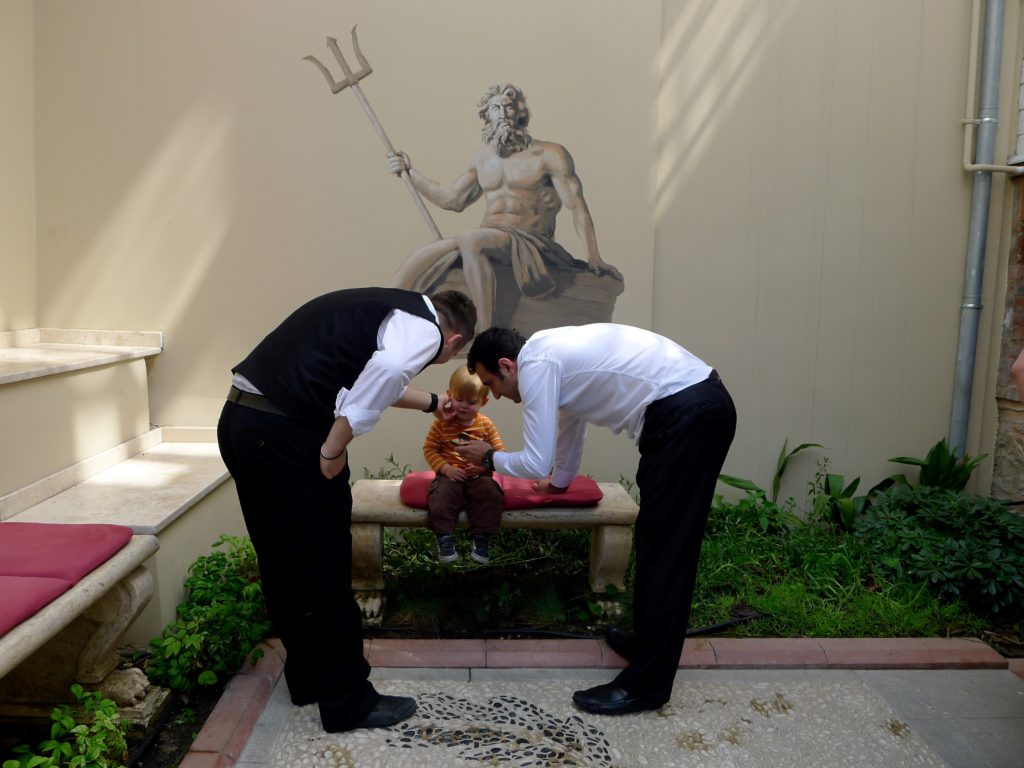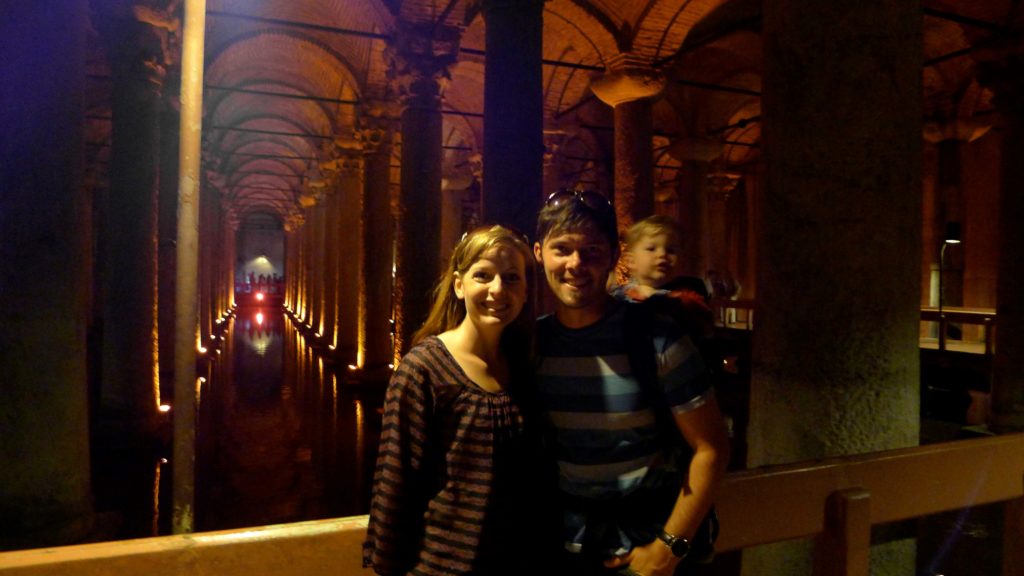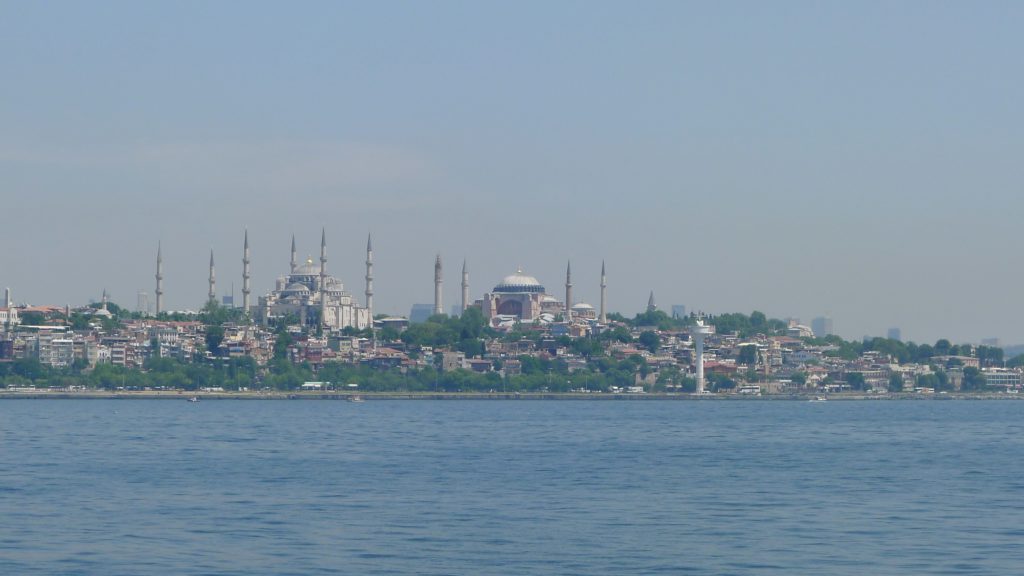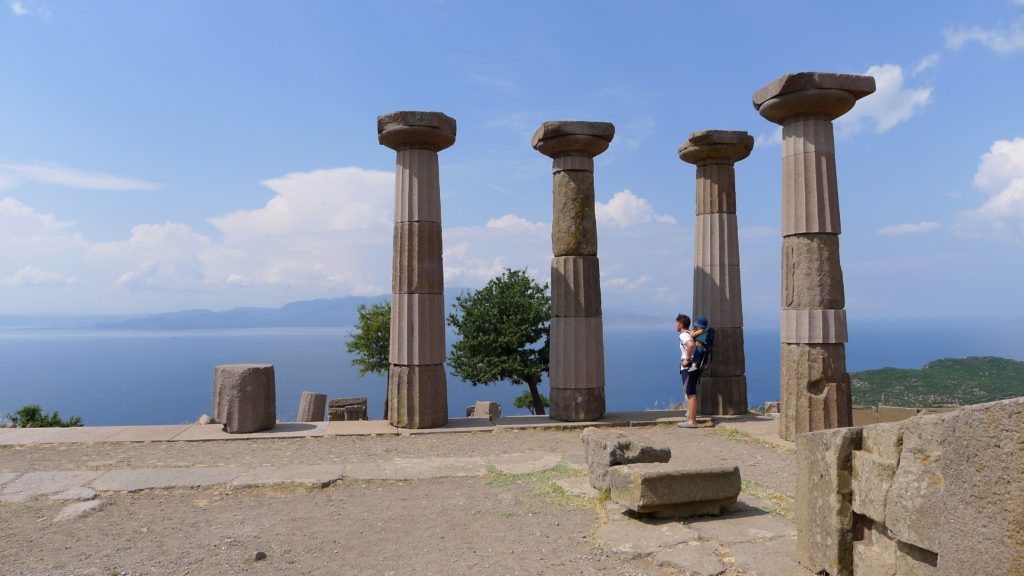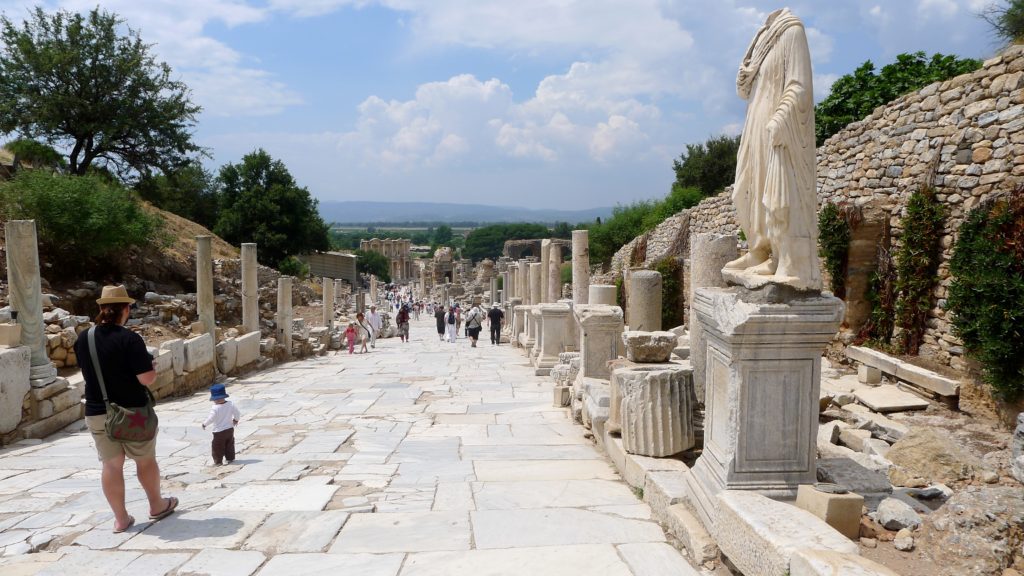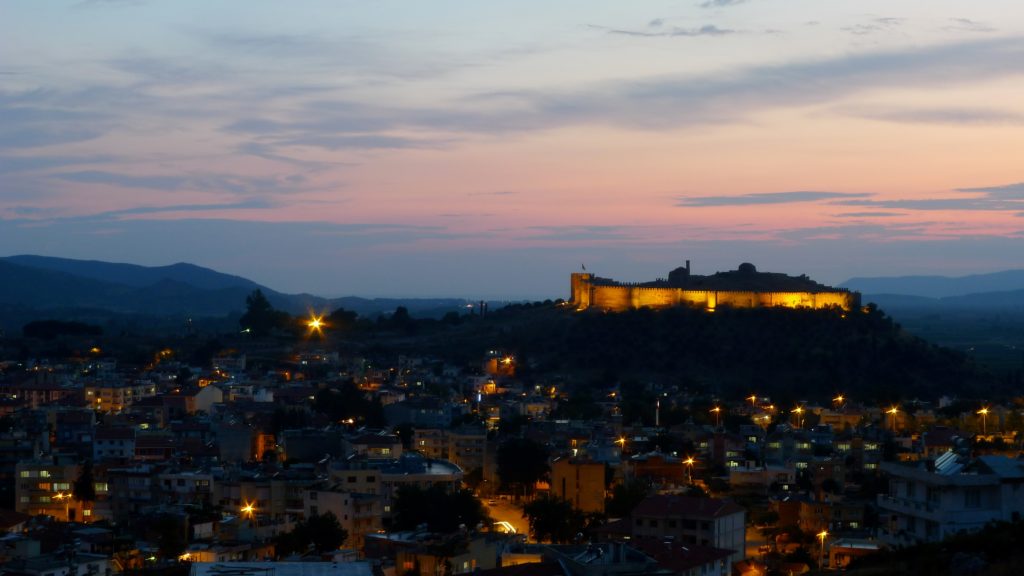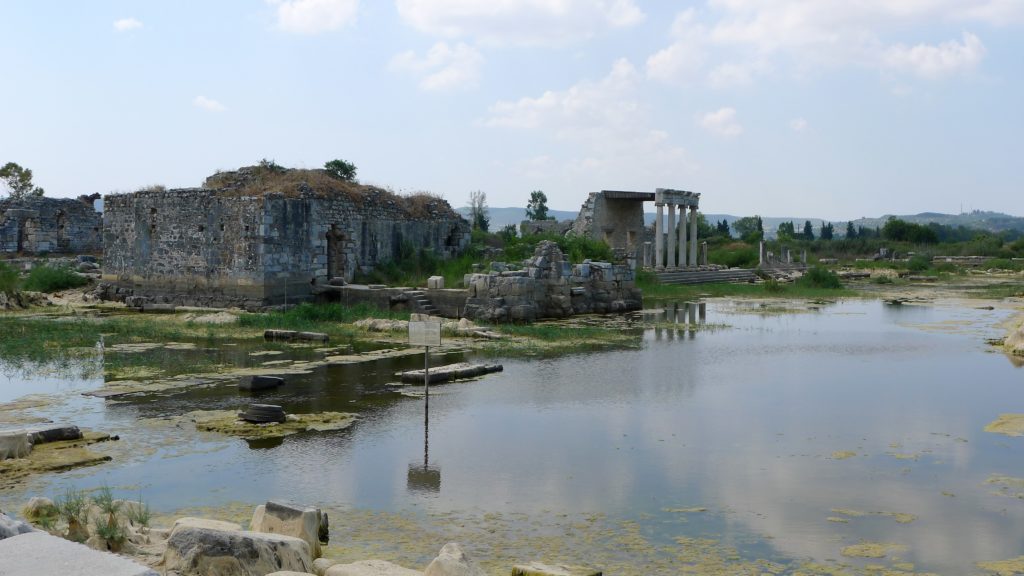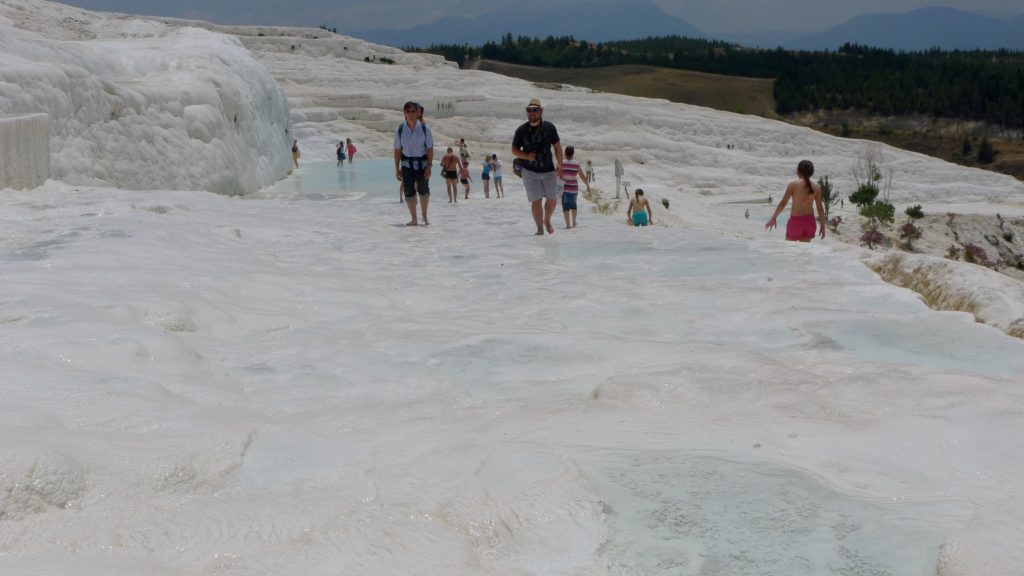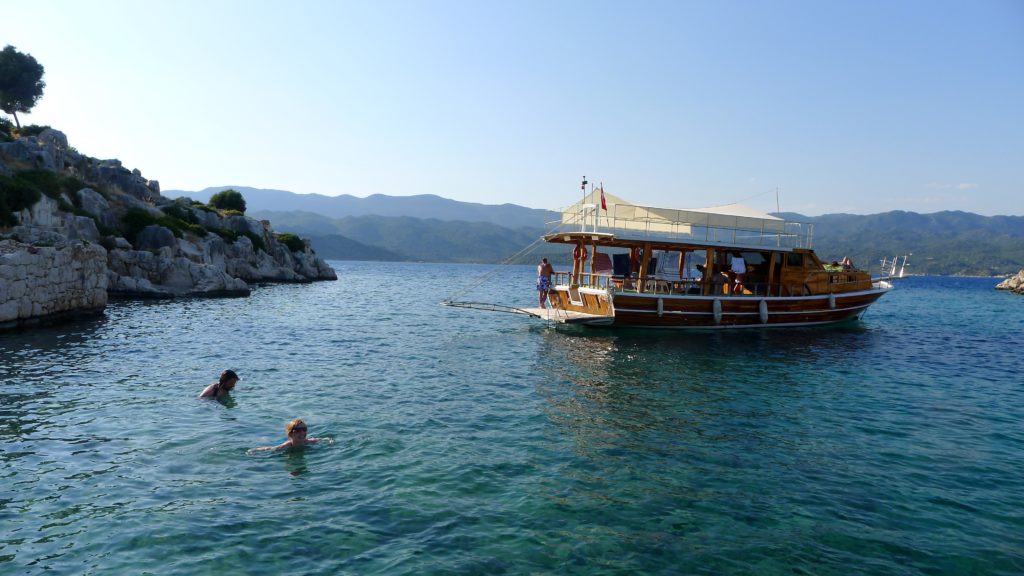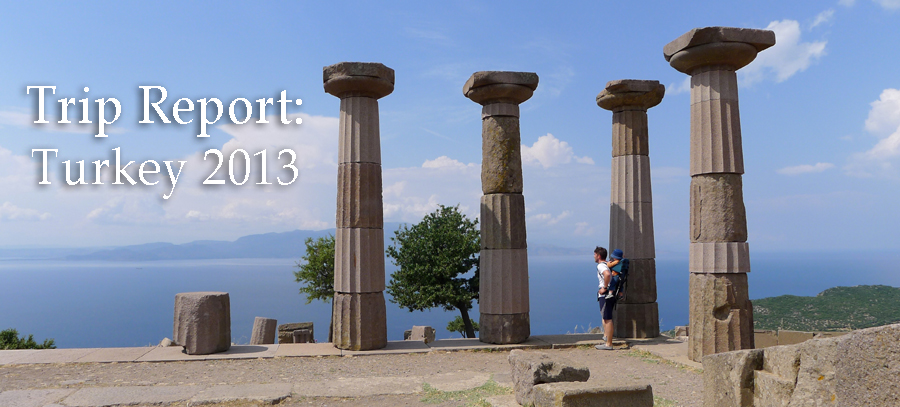 You may remember today’s Field Agent Marc from his family’s fantastic trip report from Austria.
You may remember today’s Field Agent Marc from his family’s fantastic trip report from Austria.
———————-
In 2013 my wife and I toured Western Turkey with our 1-year-old son, Oliver. We have never met a more fascinating and inspiring country than Turkey, nor have we met people more caring, friendly, or hospitable than Turks.
We were funded by our University to lay the groundwork for a new study abroad course and our task was simple: to seek out the most profound and inspiring sites relevant to history and philosophy possible. We succeeded gloriously, not necessarily because we are skilled seeker-outers of such things, but because Turkey simply has far more than its fair share of them.
Comprising half of Ancient Greece and a significant chunk of Ancient Rome, modern day Turkey boasts some of the world’s greatest archeological sites. And yet, because it has somehow remained under the radar of tourism, it remains largely untouched by the hoards that tend to dilute—even prevent—profound experiences. You know what I mean: being in the presence of something great is one thing, but being there alone can be a life-changing experience. Turkey offers many such experiences.
In our hunt we also found much more than inspiring locations. Even more than its ancient sites and tantalizing food, Turkey’s main asset has got to be its people. At once pious and secular, friendly and sincere, traditional and modern, Turks are a people of surprising charm and character. And our main asset, the one that helped us charm locals and win over hotel employees, was definitely our Oliver. His blond hair, chubby cheeks and toddlery waddle definitely helped, but Turkish people simply seem to genuinely care about the people around them, especially the little ones.
If you have a choice between bringing your kids with you to Turkey and coming alone, we definitely recommend bringing the kids; it will enhance your interactions with Turks tenfold.
We could hardly get from point A to point B without Oliver being kissed, squeezed, tickled, photographed, and sometimes even picked up and snuggled by locals. This was especially true in Istanbul, mainly because of the sheer number of people there. Near the Archeology Museum he was invited onto a parked tour bus to sit at the helm for a full 10 minutes. Within the grounds of Topkapi Palace he was picked up by a Muslim pilgrim for a photo shoot with her own children. At the Grand Bazaar Oliver was our golden ticket to bartering better prices for Turkish dishes and rugs. Inside the Hagia Sophia the guards gave him their walkie-talkies to play with, and in the neighboring park he was a favorite of the tea vendors—those tireless wanderers withgiant vats of delicious Turkish tea on their backs.
Besides its caring residents, Istanbul has so many unique and stunning things to offer. One sure to marvel children and adults alike is the Basilica Cistern, the jaw-droppingly huge underground water retention system you can wander for a few Turkish Lira. This is a less popular site and a definite “don’t miss” in our opinion.
Tip: spend a little extra money to stay in the centrally located Sultanahmet neighborhood; you’ll be within easy walking distance of all the major sites.
Istanbul completely lives up to its age-old reputation as the energetic and inspiring crossroads of East and West, and if you only had a day or two to spend in Turkey, Istanbul would probably be the wisest choice. With more time you would be well served by traveling south from Istanbul through Western Turkey, taking in some of the world’s most mind-boggling and beautiful locations, many of which are still undiscovered by the tourist hoards.
Heading south out of Istanbul, crossing the Sea of Marmara by ferry is highly recommended, as going around it by car, train, or bus would be a lengthy and relatively unremarkable journey. Besides, seeing the Blue Mosque and Hagia Sophia from the water, with their minarets commanding the skyline, is an experience you will never forget.
Tip: renting a car in Turkey seems to have mixed reviews online. In our experience it was worth it for the convenience of reaching out-of-the-way places, and it was no more or less difficult than driving in Europe. Frankly, we don’t know what all the fuss is about.
From Yalova on the southern shore of the Sea of Marmara it’s a short drive eastward to the lakeside city of Nicaea. Swimming in Lake Iznik there is a must do for history buffs, avid swimmers, or simply those who like to cool off in a lake directly above the ruins of the very palace where Catholicism was officially codified.
Tip: learn a few words of Turkish before you travel; places like Nicaea are far enough off the beaten path that English isn’t spoken much there.
Depending on what you are expecting, a visit to the ancient city of Troy—yes, the city featured in that awesome movie featuring Brad Pitt’s behind; also of Iliad fame—will yield drastically different results. If you happen to be passing by and would like to see a moderately interesting ruined Roman city in the process of excavation, studded with olive groves and tortoises, you won’t be disappointed. If, on the other end of the spectrum, you are trekking out to see first hand the high fortified walls, white beaches, and intricate city streets of Hollywood depiction, you might want to reconsider your itinerary. In fact, while it is almost definitely the very site known to Homer as the port city of Troy, it is now situated seven miles inland due to heavy silting of the nearby river.
It was at Troy that Oliver was whisked away by a band of field-tripping teenagers who kissed him and took selfies while we sat rather helplessly by. If you are a little disturbed by how creepy all that may seem, it was anything but. We could always sense that these interactions with Turks were expressions of genuine caring and delight. Even from teenagers!
Tip: Finding Troy can be challenging. Google Maps has it labeled as “Truva Ören Yeri.”
For those in the mood for philosophy, beautifully knitted local products, or stunning views of the blue, island-studded Aegean Sea, make a stop in Assos, a supremely charming hilltop village just North of the Island of Lesbos. In his later years Aristotle established an influential school of philosophy atop this hill. Today the setting of the ruins of its temple, looking out over the vast Aegean, could hardly be improved. And the food and street shopping in town are equally difficult to beat.
If you could only visit two areas of Turkey the second should be Selçuk. About an hour south of Izmir, Selçuk and its environs host an embarrassment of archeological and historical riches. Most famous is the nearby ancient city of Ephesus. A large Roman city, it boasts the stunning facade of the library of Celsus, a ginormous amphitheater, surprisingly complete public toilets, and so many other ruins you could spend an entire day here; many cruise passengers do.
To avoid the hordes at Ephesus, either visit in the late afternoon when most have returned to their cruise ships, or head to any of Selçuk’s other gems:
- The Basilica of St. John: a maze of half-standing walls and pillars, the remains of a sixth century church built on the supposed site of Saint John’s tomb.
- Ayasuluk castle: perched on Ayasuluk hill, this newly restored medieval castle offers breathtaking views, space for the kids to explore, and information to help the grown-ups learn more about the fascinating history of the area.
- Isa Bey Mosque: a rare fourteenth century mosque, important in the history of Islam and architecture in Anatolia.
- The Seven Sleepers: between Ephesus and Selçuk resides the cave of the seven sleepers of Old Testament fame.
- House of the Virgin Mary: in a tranquil setting near the top of a nearby mountain, this small church is the supposed resting place of the Virgin Mary.
- The Temple of Artemis: one of the seven wonders of the ancient world and more than twice the size of the Parthenon in Athens. Unfortunately, due to flooding and 19th century British pillagers—A.K.A. archeologists—only the foundation and a single pillar remain.
One hour’s drive south of Selçuk are a pair of absolute gems, two ruined cities of antiquity, Miletus and Priene. Miletus, once a major port city able to compete with the likes of Athens, was home to Thales and Anaximander, the first philosophers of Western history. Today, half buried in swamp water, it has been mostly reclaimed by nature, which is partly what makes this site so powerful. It’s a testament to the passage of time and the transitory nature of things on the scale of an entire city. As with so many things in Turkey, this got me thinking. Even entire cities, even entire civilizations, go extinct. Nothing is permanent. To paraphrase Anaximander himself, as soon as something is created its destruction has been initiated.
Miletus is relatively unknown to tourism industries so you’ll only have to share this spectacular site with a few other dedicated travelers. Let the kids roam free and explore to their hearts’ content the swamps and ruins therein. We recommend you do the same.
Practically next door lies the hillside city of Priene, another ruined city unknown to tourist. Most of its buildings were built by Alexander, so great was his love for this quaint city with its commanding views over the Meander River Valley. Today it has been largely infiltrated by a forest of tall pines and you and the kids will love simply wandering around Priene and exploring its unique charm.
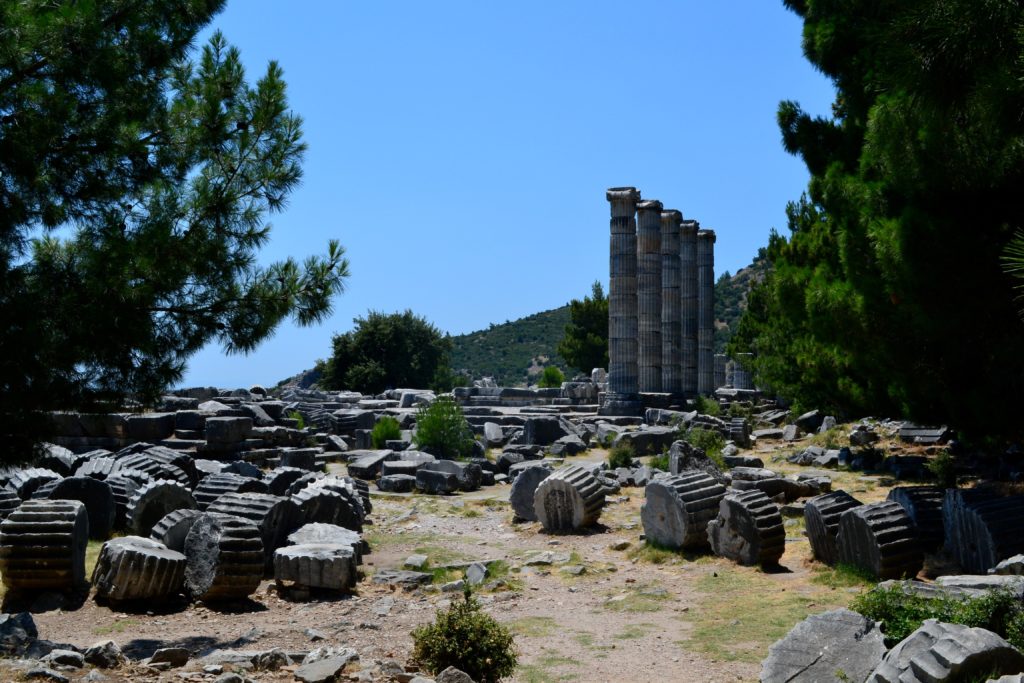
The five reconstructed pillars of Priene’s Temple of Athena, originally funded by Alexander the Great
One of the most surreal and intriguing locations in the world awaits you three hours inland from Selçuk. Hierapolis is, yes, another large ruined Roman city, but in a setting you didn’t even know was possible. It sits atop a hot spring on a mountain whose entire west face is covered in calcium calcite formations that fill with the warm spring water. Not only is it a jaw dropping site to behold, but you are allowed and encouraged to climb all over these formations, known as the Cotton Castle, or “Pamukale” in Turkish, and even to bathe in the mineral-rich waters as they cascade down the mountainside. The city at the top is a marvel in its own right. You can swim among Roman ruins in the natural pools in the center of the city, or explore any number of impressive ruins Hierapolis has to offer. We recommend booking a hotel in the neighboring town, also called Pamukale, as exploring this Unesco World Heritage site should take at least a full day.
Tip: most visitors enter the city from the parking lot at the top, but we recommend starting at the bottom and hiking up the Cotton Castle to reach the city; a hike you’ll never forget.
If you have time to venture to the southwest corner of the country we have two recommendations. Xanthos and the Sunken City. Xanthos was the capital city of a unique culture, the Lycians, who so loved their freedom that when threatened by Alexander’s rule committed mass suicide by jumping off a cliff. If you are as lucky as we were, a mustachioed local guide at Xanthos will recount the story to you in a mind-melting mix of German, English and Turkish.
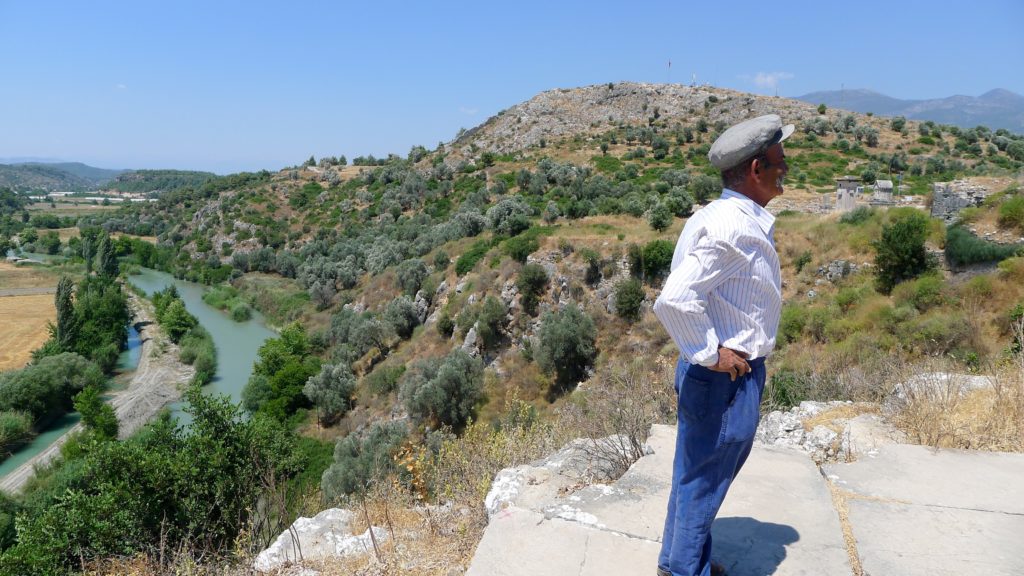
Cliffs where thousands of Lycians stuck it to Alexander by offing themselves. Also note local guide with killer mustache.
Last, but not least, in this list of sites-to-bend-your-mind-and-grow-your-soul, is the difficult-to-reach-but-entirely-worth-the-effort Sunken City. Drive to Kekova where you can hire a boat for half a day (we had one to ourselves for about $40!). Your skipper will sail you out to see the ruins of an ancient Lycian city, partly above the Mediterranean, and partly below it. In the safety of a beautiful bay you can swim and dive among the ruins—an experience as incredible as it sounds.
Like most other Turks, our sailor-guide was smitten with Oliver. As we sailed back to the quaint town of Kekova, sun setting behind us, Oliver became our new skipper, sailing us to the finish of an incredible journey through Turkish history and culture.
Wind in my hair, I reflected on what we had just experienced, an entire city that at one point in time was new and vibrantly alive, and is now not only completely abandoned but half buried by sea water. I realized that I take for granted Oliver’s youth, that he will soon grow into a teenager, a man, and eventually pass away himself and be forgotten, and like the Sunken City, this is not a tragedy but a beautiful thing. As Anaximander recognized, coming to terms with the transitory nature of life on Earth is a difficult and ongoing process, but our trip through Western Turkey brought my thoughts and feelings on the subject a long way forward.
Our time in this magnificent country was so profound, so thick and present, so thought provoking, that I’ll be forever changed. If you only go to one more country in your life, it should probably be Turkey.
